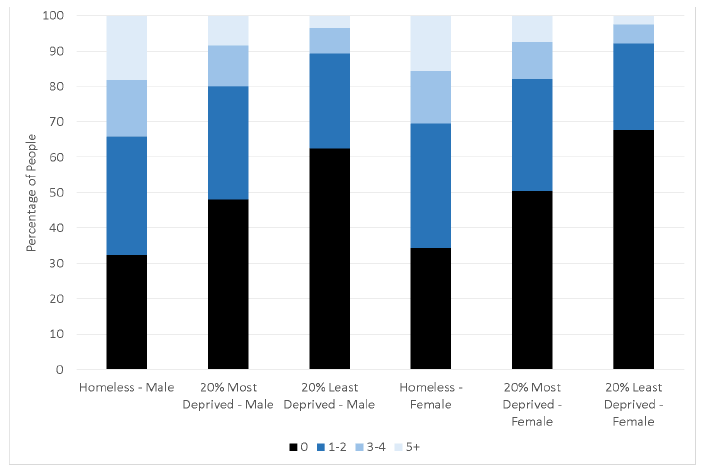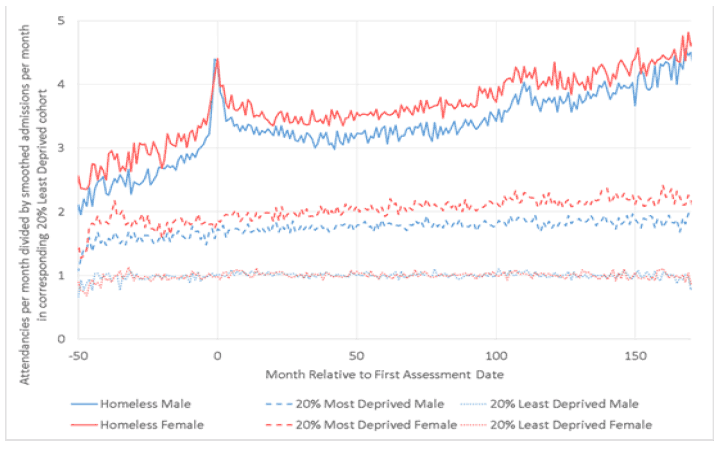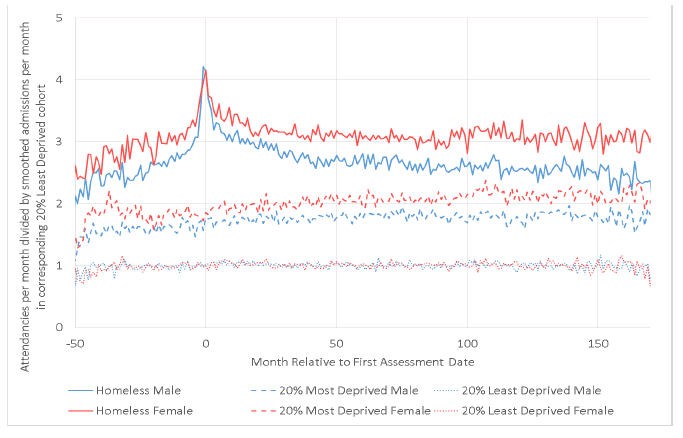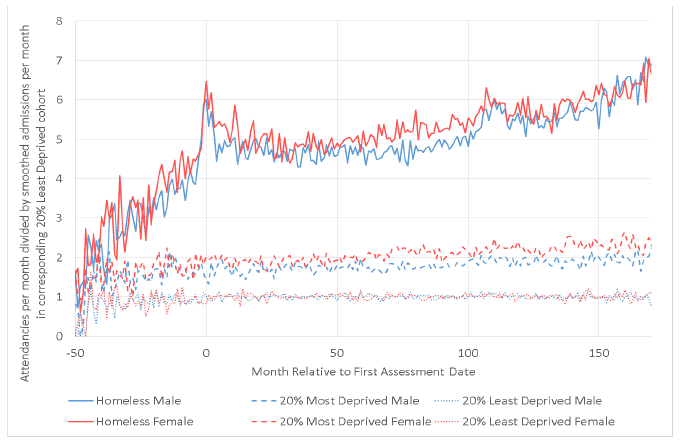Health and homelessness in Scotland: research
Study exploring the relationship between homelessness and health.
Chapter 3: Accident and Emergency Attendances
There were 2.1 million Accident and Emergency (A&E) attendances over the time period 1 January 2011 to 31 December 2016 inclusive for the 1.3 million people in the study. For more information on the A&E attendances data see Section 2.3.3.
In this chapter we discuss the study cohorts, their A&E attendance activity and how this relates to homelessness. How this relates to deprivation and health needs is discussed in Chapter 11.
3.1 Comparative activity between the EHC and their controls
Accounting for one third of all people in the study, people in the EHC (Ever Homeless Cohort) accounted for 55% of A&E attendances (29% male, 25% female). A&E Attendances amongst the MDC (Non-homeless 20% Most Deprived Cohort) accounted for 30% of attendances during the period (15% male, 14% female). The LDC (Non-homeless 20% Least Deprived Cohort) accounted for 16% of attendances (9% male, 7% female).
Table 3.1: Number of people, number of A&E attendances and the ratio of the number of A&E attendances between EHC and MDC, and between EHC and LDC, by age and sex.
| Age (at 31 March 2015) | Male | Female | ||||||
|---|---|---|---|---|---|---|---|---|
| Number of people | A&E Attendances | EHC : MDC | EHC : LDC | Number of people | A&E Attendances | EHC : MDC | EHC : LDC | |
| 0 to 15 | 135,444 | 252,290 | 1.2 | 1.5 | 127,461 | 204,874 | 1.2 | 1.7 |
| 16 to 20 | 49,263 | 95,286 | 1.4 | 2.3 | 51,276 | 95,161 | 1.7 | 3.6 |
| 21 to 25 | 64,209 | 126,352 | 2.0 | 3.7 | 78,690 | 139,249 | 2.1 | 4.9 |
| 26 to 30 | 75,363 | 128,218 | 2.2 | 5.1 | 93,003 | 132,336 | 2.1 | 5.7 |
| 31 to 35 | 70,407 | 110,710 | 2.5 | 6.1 | 74,493 | 100,050 | 2.3 | 6.4 |
| 36 to 40 | 58,347 | 89,185 | 2.6 | 6.1 | 53,259 | 70,625 | 2.2 | 5.9 |
| 41 to 45 | 55,737 | 88,911 | 2.5 | 5.9 | 48,873 | 67,155 | 2.0 | 5.3 |
| 46 to 50 | 49,818 | 78,079 | 2.3 | 5.1 | 43,563 | 62,288 | 1.9 | 4.6 |
| 51 to 55 | 37,746 | 62,720 | 2.2 | 4.9 | 31,578 | 46,884 | 1.9 | 4.0 |
| 56 to 60 | 25,017 | 40,214 | 2.1 | 4.2 | 19,017 | 26,585 | 1.8 | 3.5 |
| 61 to 65 | 15,765 | 26,007 | 2.0 | 4.2 | 11,436 | 15,579 | 1.5 | 2.8 |
| 66 or over | 21,591 | 35,125 | 1.7 | 2.7 | 16,203 | 24,260 | 1.4 | 2.2 |
| All ages | 658,707 | 1,133,097 | 1.9 | 3.4 | 648,852 | 985,046 | 1.8 | 3.7 |
In order to see how A&E attendances compare in the different cohorts, ratios of A&E attendances were constructed for each age band and sex ( Table 3.1).
The EHC have more A&E activity
In total, the EHC has almost double the number of A&E attendances compared with MDC (1.9 times for males, 1.8 for females) and over three times the number of A&E attendances compared with LDC (3.4 times for males, 3.7 times for females).
For each age and sex breakdown, the EHC have more A&E activity
Compared to the controls in the MDC or LDC, the ratio of attendances is always greater than one (minimum ratio is: 1.2, EHC : MDC at 0–15 years).
EHC people aged 31–40 years have the most A&E activity compared with their controls
The ages at which the peak ratios occur are similar for males and females. For males EHC : LDC peaks at 6.1 at 31–40 years, and EHC : MDC peaks at 2.6 at 36–40 years. For females EHC : LDC peaks at 6.4 at 31–35 years, and EHC : MDC peaks at 2.3 also at 31–35 years.
3.2 Distribution of the number of A&E attendances
The previous section found that, on average, people in the EHC had more A&E attendances than their controls. This section explores whether this is due to a higher proportion of the EHC having attendances, or a higher proportion of the EHC who had attendances having many attendances, or both ( Figure 3.1). The following points apply for both sexes:
More of the EHC had at least one A&E attendance
A higher proportion of the EHC (68% males, 66% females) had at least one A&E attendance than the MDC (52% males, 50% females) and LDC (38% males, 32% females) over the study period.
More of the EHC had many A&E attendances
A higher proportion of the EHC (18% males, 16% females) had five or more A&E attendances than the MDC (8% males, 7% females) and LDC (4% males, 3% females) over the study period. Even among people who had at least one A&E attendance, a notably higher proportion of the EHC had many attendances than the MDC and LDC.
Figure 3.1: Distribution of the number of A&E attendances for each person by sex and cohort.

3.3 A&E Attendances Relative to the Date of First Homelessness Assessment
In Section 3.1 it was found that the EHC have more A&E attendances than both control cohorts. In order to explore the relationship between homelessness and A&E activity, this section compares the timing of A&E attendances with the date of first homelessness assessment (Figure 3.2). Detail on this method is described in full in Section 2.10.
Figure 3.2: Ratio of A&E Attendances to that of the LDC, by sex, against the time difference between the first assessment and the attendance date.

The shape of the graph for the EHC is markedly different from the MDC. The following points apply for both sexes:
The MDC had consistently more A&E attendances than the LDC
The MDC had approximately double the number of A&E attendances than the LDC. This ratio is roughly constant over time. This makes sense as there would be no particular reason for the activity of people in these cohorts to change with reference to the date of first homelessness assessment. While these people will be aging alongside the EHC person they have been linked to, the date of the EHC person's first assessment will have no particular bearing on them.
Even several years before the date of first assessment, the EHC ratio is higher
Some people who go on to become homeless are more likely to have more A&E attendances, years prior to their first homeless assessment.
EHC A&E attendances increase towards assessment date
From four years prior to, to a few months before, the date of first homelessness assessment, EHC A&E attendances increase relative to LDC A&E attendances (from a ratio of around 2.25 to 3.25). The A&E attendances increasing toward the first homelessness assessment date suggests that, for some people, the homelessness episode is an outcome of a gradually worsening health condition. This underlying condition relates to both A&E attendances and eventual homelessness. In this way, this excess activity among the EHC is not a result of homelessness [36] itself: it pre-dates the first homelessness assessment.
There is a clear peak in EHC A&E attendances around assessment date
In the weeks and months immediately prior to the date of first homelessness assessment, EHC A&E attendances increase sharply (peak value of around 4.4). Notably, the observed peak is not after the date of first homelessness assessment. This suggests that becoming homeless is, for some people, part of a crisis, which has a health component.
EHC A&E attendances stabilise after the peak, but at a higher level, with an eventual rise
EHC A&E attendances stabilise one to two years following the date of first homelessness assessment for several years at a level (roughly 3.25), similar to that immediately prior to the sharp increase. Attendances do not decrease to the initial ratio in the long-run, but in fact begin to rise once again. The reason for this is explored in the next section.
If differences in A&E attendances between the cohorts were driven by deprivation alone, then the shape of the EHC line would be similar to that of the MDC. Therefore, it appears that homelessness has a relationship with A&E attendances.
3.4 A&E attendances for Once-Only and Repeat Homelessness
In the last section, EHC A&E attendance were shown to be higher after the date of first homelessness assessment than before. This could be due to more periods of homelessness, but at different times for different people, or it could be a long term effect of the original homelessness assessment. To better understand this, this section explores differences in A&E attendance ratios between those people in that have only been assessed as homeless once ( Figure 3.3) (Once-only EHC), and those who have been assessed as homeless on multiple occasions, referred to as repeat homelessness (Repeat EHC) ( Figure 3.4). More information on repeat homelessness is available in Section 2.2.
A&E attendance ratios for Repeat EHC are higher than for Once-only EHC. The following points apply for both sexes:
A&E attendance ratio increases up to the peak more rapidly for Repeat EHC
From four years prior to, to a few months before, the date of first homelessness assessment, once-only EHC ratios increase from around 2.25 to around 3 (an increase of around 1 third). This is notably less than the increase from around 2 to around 4.25 for the repeat EHC (which more than doubles). Perhaps the people who go on to have multiple homelessness episodes are more likely to be those who have a worsening underlying condition that is both related to their A&E attendances, and results in their homelessness.
The peak A&E attendance ratio is higher for Repeat EHC
The peak around the date of first homelessness assessment is larger for the repeat EHC than for the once-only EHC. The once-only ratio increases from around 3 to around 4 (around a third increase), while the repeat ratio increases a greater amount from around 4.25 to around 6 (around a 40% increase). Perhaps the people whose first homelessness episode is associated with a crisis with a health component ( i.e. those contributing to the peak) are more likely to go on to have further homelessness episodes than those who do not.
The ratio falls back to pre-homelessness levels for once-only EHC
For the once-only EHC, by around four years following the assessment date the ratio has reduced to around the level it was at two years prior to the assessment date. Perhaps these people eventually recovered from:
- adverse effects of the homelessness episode,
- the health condition that worsened leading to their homelessness, and
- any crisis around the time of homelessness.
This contrasts with the repeat EHC ratio, which remains above the ratio value immediately prior to the peak, for the remainder of the period. This could have one or more of the following causes:
- One is that further homelessness episodes are associated with health-related crises (these will occur at different times for different people leading to a smooth excess on the graph).
- Another is that these people are less likely to recover from the crisis at the first (or subsequent) homelessness episode(s).
- Lastly these people never fully recovered from the underlying health condition that is evident from before the first homelessness episode.
For Repeat EHC the ratio continues to rise above the peak levels, several years later
Around nine years after the first homelessness assessment the ratio increases above that of the peak around the first assessment date. Perhaps this is due to a cumulative health effect of the multiple homelessness episodes.
Figure 3.3: Ratio of A&E attendances for once-only homelessness to the controls in the LDC for those homeless people, by sex, against the time difference between the first assessment and the attendance date.

Figure 3.4: Ratio of A&E attendances repeat homelessness to the controls in the LDC for those homeless people, by sex, against the time difference between the first assessment and the attendance date.

3.5 Summary
The EHC have more A&E activity than the control cohorts. This is true for each age and sex breakdown, and is greatest among those aged 31–40. This is due to more of the EHC having at least one A&E attendance, and among those who do have attendances, the EHC have more with multiple attendances.
Among the EHC there is a relationship between the timing of A&E attendances and that of the first homelessness episode, suggesting some relationship between these. Most pronounced is a peak in A&E activity around the time of first homelessness assessment, with a gradual rise leading to this, and on average, higher activity afterwards. This is especially the case for those who have multiple homelessness episodes. For people who have only one homelessness assessment, the A&E activity ratio eventually returns to the level it was prior to the homelessness episode.
There is clear evidence to support each of the four research questions:
- A gradually worsening condition prior to the date of first assessment that results in additional A&E activity prior to homelessness.
- Also for some people the (first) homelessness episode is associated with some crisis with a health activity component, as observed by an A&E activity peak around that time.
- Both these effects are greater among those who go on to have multiple homelessness episodes, suggesting that these situations and crises sometimes precede not just homelessness, but repeat homelessness especially.
- The larger ratios after the first assessment date for those who have multiple homelessness episodes could be due to: further crises around the time of those later episodes, long-term effects of the earlier underlying condition, crises or homelessness itself.
- Lastly, people who go on to become homeless appear to have more A&E attendances, even several years prior to their first homeless assessment. This could be a result of the EHC having poorer general health than individuals in other cohorts, or using A&E when accessing GP services may be difficult.
Contact
There is a problem
Thanks for your feedback